|
.
"The fight was so intense that often the exhausted men and horses
rested close to one another before starting to fight again."
Digby-Smith after Seyfert, - p 49
|

Cavalry Battle at Liebertwolkwitz, 1813
"The mass of riders, with the sun glancing from their weapons and helmets,
formed one, huge, endless column which crushed all before it ... "
- Russian ADC Molostof
On October 14th 1813 at Libertwolkwitz was fought a great cavalry battle.
Digby-Smith writes: "On the evening of 13 Oct, Murat aimed to withdraw northwards
over the Parthe and to stand between Leipzig and Taucha. ... Napoleon sent an aide,
Mjr Baron Gourgaud, to stop him. ... Murat then turned back and took post on the slight
but dominant heights between Mark-kleeberg and Liebertwolkwitz. ... "
During the mighty cavalry battle, the French and Austrian infantry fought for
Liebertwolkwitz.
Prussian Cuirassiers.
"The sight of the enemy cavalry had brought
the regiment to boiling point." - von Gaffron
 Ernst Maximilian Hermann von Gaffron of the Prussian Silesian Cuirassiers describes
the first movements and charges: "In order to gain the gentle heights of Wachau and
Liebertwolkwitz, we had to pass through the defile of the pretty village of Crobern,
which lay in a shallow valley. This we did at a fast trot, with our carbines at the
ready. ...
Ernst Maximilian Hermann von Gaffron of the Prussian Silesian Cuirassiers describes
the first movements and charges: "In order to gain the gentle heights of Wachau and
Liebertwolkwitz, we had to pass through the defile of the pretty village of Crobern,
which lay in a shallow valley. This we did at a fast trot, with our carbines at the
ready. ...
Once through the village, we at once went into a gallop, first in troops,
then on a regimental frontage. ...
A dark mass stood against us ... soon I saw the
flashing of helmets and swords as they closed with us. The signal 'Gallop' sounded,
and now I could see the enemy squadron clearly.
The regiment was going at such a pace that even before the commanded 'March, march' came, a thunderous cheer broke from
our ranks. ... The French dragoons, whose moustachioed faces I could now clearly see,
stopped, suddenly turned, and withdrew in good formation. We soon caught up with them
as they were only about 20 paces before us. The sight of the enemy cavalry had brought
the regiment to boiling point. ..."
"Finally, we managed to break into their ranks ..."
"The [Russian] Grodno Hussars were, as usual,
brilliant in this combat." - von Gaffron
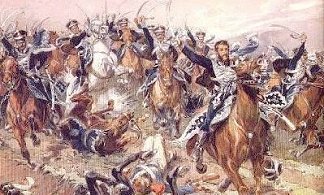 Von Gaffron continues: "The enemy dragoons were from Milhaud's first line.
As far as I remember, the Grodno Hussars were first through the Crobern defile,
then our regiment ... The Grodno Hussars were, as usual, brilliant in this combat.
The other regiments followed us as quickly as they could clear the defile. ...
There was no order in the ranks anymore, everyone rode like a wind. ...
Von Gaffron continues: "The enemy dragoons were from Milhaud's first line.
As far as I remember, the Grodno Hussars were first through the Crobern defile,
then our regiment ... The Grodno Hussars were, as usual, brilliant in this combat.
The other regiments followed us as quickly as they could clear the defile. ...
There was no order in the ranks anymore, everyone rode like a wind. ...
The French dragoons retired before us, initially at a trot, then at a gallop, in good
formation. We often heard the officers calling: 'close ranks !' and in fact, they
rode so closely together that at first we could not break their ranks, but stayed
close on their heels and hacked at them as best we could.
The horse-tail manes of their helmets ... and the rolled greatcoats, which they
wore over their shoulders, protected them so well that they were pretty impervious to cuts,
and our Silesians were not trained to thrust nor were our broad-bladed swords long enough
to reach them.
... Finally, we managed to break into their ranks and they burst apart.
As our regiment was now out of order, the combat developed into a series of small,
fighting groups ... We chased them, and fought with, the enemy for a long while;
we threw his first line back onto the second, and his second onto his third.
Suddenly, the enemy's ranks broke apart in front of us; a horse battery had become
jammed in the mess of the dragoons and was soon surrounded by our men.
We cut down the gunners and the drivers, or forced the latter to turn the guns around."
French Counterattack.
"large groups of French cavalry appeared
and came at us." - von Gaffron
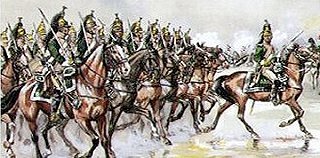 The French however were not finished yet. Gaffron writes: "... when suddenly I heard:
En avant, dragons, a bas ces foutous Prussiens ! coming from all sides ! I then realised that I and about 20-50 cuirassiers in the captured
battery were surrounded by hostile dragoons. A colonel of the enemy dragoons, a tall,
handsome man on a large, English thoroughbred light chestnut, decked out in the finest
equipment, called his dragoons tegether and charged us.
The French however were not finished yet. Gaffron writes: "... when suddenly I heard:
En avant, dragons, a bas ces foutous Prussiens ! coming from all sides ! I then realised that I and about 20-50 cuirassiers in the captured
battery were surrounded by hostile dragoons. A colonel of the enemy dragoons, a tall,
handsome man on a large, English thoroughbred light chestnut, decked out in the finest
equipment, called his dragoons tegether and charged us.
The captured guns were abandoned; our small group of cuirassiers would have to cut their
way out. ... Some cuirassiers were behind me; I heard one cry 'Jesus Maria !' as one of
them was cut down. ... A closed line of cavalry was approaching me from the right.
I took them for Prussians and rode towards them; then I saw that they were wearing bearskins
so I turned off to the right. (Men of the elite company in French dragoon regiment wore
bearskins.)
After a short while, I met a troop of cuirassiers who had gathered themselves around Ltn
von Poser, commander of the escort to the standard. Here the remnants of the regiment
gathered .... We didn't have much of a rest; large groups of French cavalry appeared and
came at us. We charged against them, but didn't stand much of a chance against their
superior numbers, until suddenly the Neumark Dragoons hit the enemy in the flank.
We now joined up with our dragoons and charged the enemy and threw them back into a deep,
sunken lane where many men and horses fell and filled the ditch. We now reformed line and
stood at the ready. A heavy artillery duel now began."
Cavalry Battle.
"The fight was hectic, bitter." - Dr Seyfert
Dr Seyfert, the vicar of Taucha, recounts the ensuing combats as follows: 'Pahlen had
expected to snatch an early victory but was overthrown; the Izum and Grodno Hussars were
driven off in confusion. ... In the Allied centre ... was the Soumy Hussars and a Russian
horse battery. This battery fired on the French cavalry: two of the enemy regiments charged
the battery, which only managed to limber up and escape in time. The Soumy Hussars
counter-attacked but were outnumbered and had to flee into Gulden-Gossa. At this point,
the Prussian Neumark Dragoons arrived ... and charged forward together with the Russians.
The fight was hectic, bitter."
 Edouard von Lowenstern (of Russian hussars) writes: "Graf Pahlen was always at the
head of his regiments, between the cavalry lines of the enemy and his own side. He led the
charges himself and directed the reserves.
Edouard von Lowenstern (of Russian hussars) writes: "Graf Pahlen was always at the
head of his regiments, between the cavalry lines of the enemy and his own side. He led the
charges himself and directed the reserves.
He was always in the thick of the fight, where it
was most critical, with only a light riding whip in his hand; giving orders calmly.
If I had been an enthusiastic admirer of his in the past, I now had to honour and admire
him even more. ... Murat had commanded the enemy cavalry and had made much use of Pajol's
dragoons, which had only come back from Spain in the summer ... "
Murat's Offensive.
"5,000 [French] cavalry advanced
in an apparently invincible mass. "
- Dr Seyfert
 Dr Seyfert continues: "Murat now threw in Milhaud's dragoons with L'Heritier's and Subervie's men in second and
third lines. Approx. 5,000 cavalry advanced in an apparently invincible mass. ... At this
critical point, General Roder came up with the Brandenbourg and Silesian Cuirassiers,
the heavy French phalanx was hit in right flank. Due to their close formation, most of
the French troopers could not use their weapons and the whole mass was pushed back to Wachau.
Dr Seyfert continues: "Murat now threw in Milhaud's dragoons with L'Heritier's and Subervie's men in second and
third lines. Approx. 5,000 cavalry advanced in an apparently invincible mass. ... At this
critical point, General Roder came up with the Brandenbourg and Silesian Cuirassiers,
the heavy French phalanx was hit in right flank. Due to their close formation, most of
the French troopers could not use their weapons and the whole mass was pushed back to Wachau.
There, however, the three Prussian cuirassier regiments were confronted by French infantry
and surrounded by the enemy's hussars, and chasseurs. There was no plan, the regiments
were thrown into the melee as they came up. It was chaos, friend and foe mixed together.
The fight was so intense that often the exhausted men and horses rested close to one another
before starting to fight again.
Gradually, after a hard fight, the [Prussian] cuirassiers were beaten
back and were taken up by the Neumark Dragoons. Murat was in the thick of it. ...
he came very close to being captured."
Von Gaffron: "Murat was at the point of being captued in one of the
melees. It is not certain if it was Ltn von Lippe of the Neumark Dragoons or Mjr von Bredow
of the Brandenburg Cuirassiers who challenged Murat to surrender. ... [He] came up on the
left side of Murat and shouted: 'Surrender, king !" At this moment, the king's Master of
Horse, who reported the incident, stabbed the brave officer in the side with a stiletto
and killed him."
Murat's Second Offensive.
"Like a great, shining snake, the massive column
of [French] horsemen burst out of the smoke
and bore down on the Allies."
 "At 2 PM Murat concentrated his cavalry for another assault.
Milhaud's Spanish veterans were again at the head of the column.
L'Heritier's dragoons behind them, then Subervie and then Berkheim.
The assault went due south. Like a great, shining snake, the massive column of horsemen burst out of the smoke
and bore down on the Allies. As the Russian ADC Molostof said: 'All shrank back
from this glistering vision which embodied for us the magic that surrounded Napoleon's brows.
The mass of riders, with the sun glancing from their weapons and helmets, formed one, huge,
endless column which crushed all before it and hit the Prussians particularly hard.'
"At 2 PM Murat concentrated his cavalry for another assault.
Milhaud's Spanish veterans were again at the head of the column.
L'Heritier's dragoons behind them, then Subervie and then Berkheim.
The assault went due south. Like a great, shining snake, the massive column of horsemen burst out of the smoke
and bore down on the Allies. As the Russian ADC Molostof said: 'All shrank back
from this glistering vision which embodied for us the magic that surrounded Napoleon's brows.
The mass of riders, with the sun glancing from their weapons and helmets, formed one, huge,
endless column which crushed all before it and hit the Prussians particularly hard.'
But the fire of the four Russian and Prussian horse batteries ... hit the front and right
flank of the column and ripped its head apart. stopping it in its tracks. Seizing the
opportunity, the Russian hussars, with the Prussian uhlans and cuirassiers, charged into
the disorganized front ranks.
At the same time, Desfours led the fresh Austrian Emperor
Cuirassiers and O'Reilly Chevauxlegeres into the melee.
They advanced and ploughed into the left flank of the closely-packed enemy column.
This completed the confusion of Milhaud's division and threw them back onto L'Herithier's men.
In a few minutes Murat's great column burst apart in all directions in panic and fled the
field. They could only be rallied at Probstheida, some 4 km to the north.
It was about 4 PM. ... In some ways it was a foretaste of the needless sacrifice of the
French cavalry at Waterloo in 1815."
|

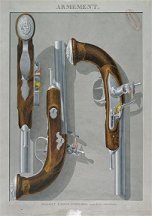 1. 1805: Cavalry Combat at Austerlitz
1. 1805: Cavalry Combat at Austerlitz
 In the midst of the battle while General Vandamme (of Soult's Corps) was ascending the Heights of Pratzen,
Marshal Lannes struggled with the skilled General Petr Bagration, a conflict took place
in the presence of Napoleon which gave a finishing blow to the battle.
In the midst of the battle while General Vandamme (of Soult's Corps) was ascending the Heights of Pratzen,
Marshal Lannes struggled with the skilled General Petr Bagration, a conflict took place
in the presence of Napoleon which gave a finishing blow to the battle.
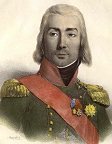 The French Guard Cavalry at Austerlitz was comamnded by Marshal Jean Baptiste Bessières, duke of Istria.
As a commander of cavalry, Bessières enjoyed a reputation excelled only by very few of
marshals. Promoted general of division in 1802 and marshal of France in 1804.
Bessieres had courage and cool judgment and was capable of independent command.
He was personally beloved to an extraordinary extent amongst his guardsmen.
At Austerlitz the Guard cavalry was made of battle-hardened veterans.
The French Guard Cavalry at Austerlitz was comamnded by Marshal Jean Baptiste Bessières, duke of Istria.
As a commander of cavalry, Bessières enjoyed a reputation excelled only by very few of
marshals. Promoted general of division in 1802 and marshal of France in 1804.
Bessieres had courage and cool judgment and was capable of independent command.
He was personally beloved to an extraordinary extent amongst his guardsmen.
At Austerlitz the Guard cavalry was made of battle-hardened veterans. Bessieres took 9,5 squadron of
Bessieres took 9,5 squadron of  The
The  In the beginning of the engagement Constantine deployed his troops as follow:
in the first line stood two regiments of Guard infantry separated by 10 guns, in the second line
were one regiment and one battalion of infantry. On the flanks of the second line stood Lifeguard
Horse and Lifeguard Hussars.
In the beginning of the engagement Constantine deployed his troops as follow:
in the first line stood two regiments of Guard infantry separated by 10 guns, in the second line
were one regiment and one battalion of infantry. On the flanks of the second line stood Lifeguard
Horse and Lifeguard Hussars.
 Grand Duke unleashed his cavalry against the hard-pressing French infantry.
The Lifeguard Horse attacked one battalion of the 4th Line Infantry (approx. 800 men) and broke it.
Major Bigarre received 25 saber cuts. One battalion of 24th Light Infantry (600 men) decided to rescue
their comrades and was also mauled by the Russians.
Grand Duke unleashed his cavalry against the hard-pressing French infantry.
The Lifeguard Horse attacked one battalion of the 4th Line Infantry (approx. 800 men) and broke it.
Major Bigarre received 25 saber cuts. One battalion of 24th Light Infantry (600 men) decided to rescue
their comrades and was also mauled by the Russians.
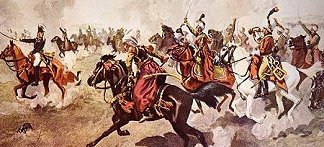 With the hussars being in full flight, Morland and Rapp came down upon the two regiments of
Guard infantry. One regiment (2 battalions) was deployed in vineyards whereas the other
regiment was in open plain with its 2 battalions formed in squares. Six Russian guns
attached to the infantry,
opened canister fire. The brave Morland was killed.
Dahlmann's chasseurs joined Morland's and Rapp's men.
It was saber against bayonet fight, infantryman versus man on horse.
With the hussars being in full flight, Morland and Rapp came down upon the two regiments of
Guard infantry. One regiment (2 battalions) was deployed in vineyards whereas the other
regiment was in open plain with its 2 battalions formed in squares. Six Russian guns
attached to the infantry,
opened canister fire. The brave Morland was killed.
Dahlmann's chasseurs joined Morland's and Rapp's men.
It was saber against bayonet fight, infantryman versus man on horse.
 Kostanetzki, "The Russian Hercules" used his ramrod with expertise :-)
The Mamelukes however managed to capture 4 of the 6 guns.
Abamelek's men and two other squadrons of hussars counterattacked.
The French cavalry threw them back.
Meanwhile on the other flank, the Lifeguard Horse with 4 horse guns, slowly fell back.
With the Russian cavalry and artillery gone, the French brought up Dogereau's
Guard horse battery and opened fire on the retreating Guard infantry.
Dahlmann's (?) and Rapp (?) squadrons then charged but the infantry formed
squares and repulsed them. Only the Mammelukes managed to hack their way into one of the squares and broke it.
Other squares renewed their retreat and crossed the Rausnitz Stream under
fire from the skirmishers and horse battery.
Kostanetzki, "The Russian Hercules" used his ramrod with expertise :-)
The Mamelukes however managed to capture 4 of the 6 guns.
Abamelek's men and two other squadrons of hussars counterattacked.
The French cavalry threw them back.
Meanwhile on the other flank, the Lifeguard Horse with 4 horse guns, slowly fell back.
With the Russian cavalry and artillery gone, the French brought up Dogereau's
Guard horse battery and opened fire on the retreating Guard infantry.
Dahlmann's (?) and Rapp (?) squadrons then charged but the infantry formed
squares and repulsed them. Only the Mammelukes managed to hack their way into one of the squares and broke it.
Other squares renewed their retreat and crossed the Rausnitz Stream under
fire from the skirmishers and horse battery.
 Rapp (see picture) counterattacked, throwing Depreradovich's men into confusion. The Russians fled
receiving again point-blank fire from infantry. Rapp and Dahlmann then went after
Chernzozubov's Lifeguard Cossacks.
Rapp (see picture) counterattacked, throwing Depreradovich's men into confusion. The Russians fled
receiving again point-blank fire from infantry. Rapp and Dahlmann then went after
Chernzozubov's Lifeguard Cossacks.
 Rapp's Guard chasseurs were sabared and pushed back. They were in dire
straits, and as Jean-Roch Coignet put it "... we were afraid that our comrades were going
to be cut up" (Jean-Roch Coignet - "Les Cohiers du Capitaine Coignet *1799-1813
Paris 1883, p 473)
Rapp's Guard chasseurs were sabared and pushed back. They were in dire
straits, and as Jean-Roch Coignet put it "... we were afraid that our comrades were going
to be cut up" (Jean-Roch Coignet - "Les Cohiers du Capitaine Coignet *1799-1813
Paris 1883, p 473)
 Ordener's 4 squadrons of Guard grenadiers advanced from behind
infantry clutching their long sabers and shouting, "Let the ladies in St. Petersburg to cry!"
It was Bessieres third line and reserve. The fight was sharp but short. The Russians were thrown back and pursued until Krenowitz.
Ordener's 4 squadrons of Guard grenadiers advanced from behind
infantry clutching their long sabers and shouting, "Let the ladies in St. Petersburg to cry!"
It was Bessieres third line and reserve. The fight was sharp but short. The Russians were thrown back and pursued until Krenowitz.

 1st Horse Carabiniers Regiment [577 men in 4 squadrons, in April 1807]
1st Horse Carabiniers Regiment [577 men in 4 squadrons, in April 1807] 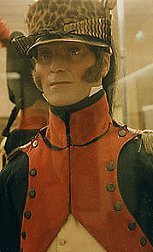 Not only the heavy cavalry was involved, the dragoons also had their share of fighting.
The green-clad dragoons were under the command of Latour-Maubourg, Grouchy and Milhaud.
Grouchy wrote that he himself led his dragoons in 15 charges (!) In short breaks between
the charges the French and Russian horse artillery cannonaded the cavalry.
Not only the heavy cavalry was involved, the dragoons also had their share of fighting.
The green-clad dragoons were under the command of Latour-Maubourg, Grouchy and Milhaud.
Grouchy wrote that he himself led his dragoons in 15 charges (!) In short breaks between
the charges the French and Russian horse artillery cannonaded the cavalry.
 General Emmanuel marquis Grouchy's 2nd Dragoon Division:
General Emmanuel marquis Grouchy's 2nd Dragoon Division: 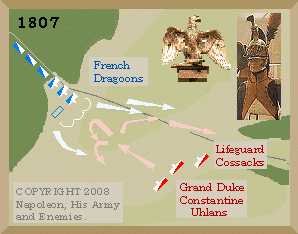 The column of French dragoons halted and stood motionless like a stonewall
[kak kamennaia stiena] waiting for the enemy. The dragoons from the second rank
grabbed their muskets and began firing while these in the first rank drew sabers and waited.
The charging uhlans first slowed down and then halted.
The column of French dragoons halted and stood motionless like a stonewall
[kak kamennaia stiena] waiting for the enemy. The dragoons from the second rank
grabbed their muskets and began firing while these in the first rank drew sabers and waited.
The charging uhlans first slowed down and then halted.
 Russian General Lambert was ordered to scout the extreme left of the French battleline.
He had three regiments: Grand Duke Constantine's Uhlans, Lifeguard Hussars (3 squadrons) and the black clad
Alexandria Hussars. They passed through a wood and saw the French.
The French trumpets sounded and the dragoons and cuirassiers immediately mounted their horses.
Russian General Lambert was ordered to scout the extreme left of the French battleline.
He had three regiments: Grand Duke Constantine's Uhlans, Lifeguard Hussars (3 squadrons) and the black clad
Alexandria Hussars. They passed through a wood and saw the French.
The French trumpets sounded and the dragoons and cuirassiers immediately mounted their horses.
 Bulgarin wrote that the French tactics was different from the Russian. The cuirassiers and
dragoons attacked in slow pace, formed in three deep columns. One column attacked
from the front and two from the flanks.
With the daylight glitting from their helmets these dark phalanxes of heavy cavalry
moved against Uvarov's hussars and guardsmen.
Bulgarin wrote that the French tactics was different from the Russian. The cuirassiers and
dragoons attacked in slow pace, formed in three deep columns. One column attacked
from the front and two from the flanks.
With the daylight glitting from their helmets these dark phalanxes of heavy cavalry
moved against Uvarov's hussars and guardsmen.
 Loraine Petre described the cavalry battle at Alt-Eglofsheim in detail.
Austrian cavalry line stood in front of Alt-Eglofsheim and stretched north-eastwards beyond
it. Their cuirassiers in two lines in the centre, but with a front of only one
regiment, opposed to the three of Nansouty. The light cavalry were on the flanks of the
cuirassiers.
Loraine Petre described the cavalry battle at Alt-Eglofsheim in detail.
Austrian cavalry line stood in front of Alt-Eglofsheim and stretched north-eastwards beyond
it. Their cuirassiers in two lines in the centre, but with a front of only one
regiment, opposed to the three of Nansouty. The light cavalry were on the flanks of the
cuirassiers.
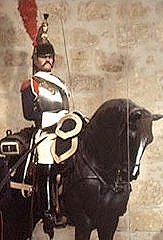
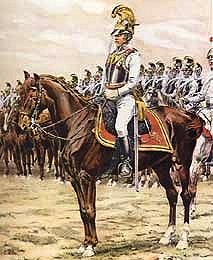 At the trot still, the French line meets the Austrian galloping
horsemen in a fearful crash which drives each front line back on its supports.
Each penetrates the other, whilst the light cavalry meet on either flank.
At the trot still, the French line meets the Austrian galloping
horsemen in a fearful crash which drives each front line back on its supports.
Each penetrates the other, whilst the light cavalry meet on either flank.
 Next day I left, feeling dissatisfied - a feeling which grew considerably when, arriving at Sebastiani's headquarters, I found him clad only in his shirt, resting on a camp-bed in the middle of
a room in an inn, under a tent of green cloth, rubbing his shins !
Stupefied at his sight, I began to fear seriously for his advance guards, and for him
personally."
Next day I left, feeling dissatisfied - a feeling which grew considerably when, arriving at Sebastiani's headquarters, I found him clad only in his shirt, resting on a camp-bed in the middle of
a room in an inn, under a tent of green cloth, rubbing his shins !
Stupefied at his sight, I began to fear seriously for his advance guards, and for him
personally."
 And next day, sure enough, comes "the nastiest news - viz. that the Russian general
Kulniev had crossed the Dwina with 5,000 cavalry and infantry, and having thrown a bridge
over the island without being seen, had fallen on Uminski's advance guard, crushed it,
rounded on St.Geniez's brigade and taken it prisoner - a defeat the more painful for its
being our first, and for a French general being captured in it."
(Britten-Austin - "1812 The March on Moscow" pp 105-106)
And next day, sure enough, comes "the nastiest news - viz. that the Russian general
Kulniev had crossed the Dwina with 5,000 cavalry and infantry, and having thrown a bridge
over the island without being seen, had fallen on Uminski's advance guard, crushed it,
rounded on St.Geniez's brigade and taken it prisoner - a defeat the more painful for its
being our first, and for a French general being captured in it."
(Britten-Austin - "1812 The March on Moscow" pp 105-106)
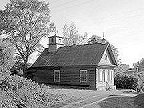 When he had reached a some way beyond the little town of Drouia, General St.Geniez, on the
orders of Sebastiani, put his troops into bivouac some 200 paces from the river, which was
believed to be uncrossable without boats. Wittgenstein, however, knew of a
ford, and during the night he made use of it to send across the river a division of cavalry,
which fell on the French troops and captured almost the entire brigade, including General
St.Geniez. This forced Sebastiani to hurry upstream with the rest of his division to make
contact with the Corps commanded by Montbrun. After this swift raid, Wittgenstein recalled
his troops and continued his march up the Dvina. The affair did Sebastiani's
reputation a great deal of harm and drew down on his head the reproaches of the Emperor."
When he had reached a some way beyond the little town of Drouia, General St.Geniez, on the
orders of Sebastiani, put his troops into bivouac some 200 paces from the river, which was
believed to be uncrossable without boats. Wittgenstein, however, knew of a
ford, and during the night he made use of it to send across the river a division of cavalry,
which fell on the French troops and captured almost the entire brigade, including General
St.Geniez. This forced Sebastiani to hurry upstream with the rest of his division to make
contact with the Corps commanded by Montbrun. After this swift raid, Wittgenstein recalled
his troops and continued his march up the Dvina. The affair did Sebastiani's
reputation a great deal of harm and drew down on his head the reproaches of the Emperor."
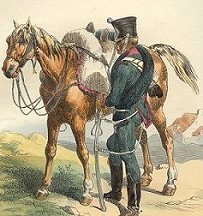 GdB St. Gèniez's Light Cavalry Brigade:
GdB St. Gèniez's Light Cavalry Brigade: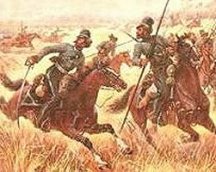 The combat at Drouia began with the Cossacks chasing the French outposts toward the village of
Onikshty where stood Polish 10th Hussars and French 11th Chasseurs.
The combat at Drouia began with the Cossacks chasing the French outposts toward the village of
Onikshty where stood Polish 10th Hussars and French 11th Chasseurs.
 Kulniev formed the hussars in two lines, four squadrons of the I Battalion in the first
line, and four squadrons of the II Battalion were in the second. The Cossacks were placed on the flanks.
The entire force was screened with horse skirmishers. (See map -->)
Kulniev formed the hussars in two lines, four squadrons of the I Battalion in the first
line, and four squadrons of the II Battalion were in the second. The Cossacks were placed on the flanks.
The entire force was screened with horse skirmishers. (See map -->)
 PS.
PS. Ernst Maximilian Hermann von Gaffron of the Prussian Silesian Cuirassiers describes
the first movements and charges: "In order to gain the gentle heights of Wachau and
Liebertwolkwitz, we had to pass through the defile of the pretty village of Crobern,
which lay in a shallow valley. This we did at a fast trot, with our carbines at the
ready. ...
Ernst Maximilian Hermann von Gaffron of the Prussian Silesian Cuirassiers describes
the first movements and charges: "In order to gain the gentle heights of Wachau and
Liebertwolkwitz, we had to pass through the defile of the pretty village of Crobern,
which lay in a shallow valley. This we did at a fast trot, with our carbines at the
ready. ...  Edouard von Lowenstern (of Russian hussars) writes: "Graf Pahlen was always at the
head of his regiments, between the cavalry lines of the enemy and his own side. He led the
charges himself and directed the reserves.
Edouard von Lowenstern (of Russian hussars) writes: "Graf Pahlen was always at the
head of his regiments, between the cavalry lines of the enemy and his own side. He led the
charges himself and directed the reserves.
 Dr Seyfert continues: "Murat now threw in Milhaud's dragoons with L'Heritier's and Subervie's men in second and
third lines. Approx. 5,000 cavalry advanced in an apparently invincible mass. ... At this
critical point, General Roder came up with the Brandenbourg and Silesian Cuirassiers,
the heavy French phalanx was hit in right flank. Due to their close formation, most of
the French troopers could not use their weapons and the whole mass was pushed back to Wachau.
Dr Seyfert continues: "Murat now threw in Milhaud's dragoons with L'Heritier's and Subervie's men in second and
third lines. Approx. 5,000 cavalry advanced in an apparently invincible mass. ... At this
critical point, General Roder came up with the Brandenbourg and Silesian Cuirassiers,
the heavy French phalanx was hit in right flank. Due to their close formation, most of
the French troopers could not use their weapons and the whole mass was pushed back to Wachau.
 "At 2 PM Murat concentrated his cavalry for another assault.
Milhaud's Spanish veterans were again at the head of the column.
L'Heritier's dragoons behind them, then Subervie and then Berkheim.
The assault went due south. Like a great, shining snake, the massive column of horsemen burst out of the smoke
and bore down on the Allies. As the Russian ADC Molostof said: 'All shrank back
from this glistering vision which embodied for us the magic that surrounded Napoleon's brows.
The mass of riders, with the sun glancing from their weapons and helmets, formed one, huge,
endless column which crushed all before it and hit the Prussians particularly hard.'
"At 2 PM Murat concentrated his cavalry for another assault.
Milhaud's Spanish veterans were again at the head of the column.
L'Heritier's dragoons behind them, then Subervie and then Berkheim.
The assault went due south. Like a great, shining snake, the massive column of horsemen burst out of the smoke
and bore down on the Allies. As the Russian ADC Molostof said: 'All shrank back
from this glistering vision which embodied for us the magic that surrounded Napoleon's brows.
The mass of riders, with the sun glancing from their weapons and helmets, formed one, huge,
endless column which crushed all before it and hit the Prussians particularly hard.'
